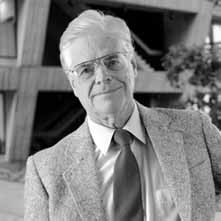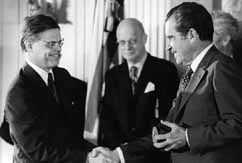 |
|
Robert Rathbun Wilson: by Mike Perricone
 Robert Rathbun Wilson, a Wyoming cowboy who built the world's highest-energy particle accelerator laboratory with the eye of an artist, the shrewdness of a banker and the conscience of a human rights activist, died late on Sunday night, January 16, 2000, at a retirement home in Ithaca, New York, near Cornell University, after a long illness. He was 85.
Robert Rathbun Wilson, a Wyoming cowboy who built the world's highest-energy particle accelerator laboratory with the eye of an artist, the shrewdness of a banker and the conscience of a human rights activist, died late on Sunday night, January 16, 2000, at a retirement home in Ithaca, New York, near Cornell University, after a long illness. He was 85.
Wilson was not only a pioneering scientist, but a powerful spokesman for science. He reached a height of eloquence in his testimony before the Congressional Joint Committee on Atomic Energy in 1969. He was asked by Rhode Island Senator John Pastore about the value of high-energy physics research in the support of national defense. "It has nothing to do directly with defending our country, except to make it worth defending," Wilson said. Wilson--physicist, artist, sculptor, writer--put his personal stamp on every aspect of Fermilab (originally the National Accelerator Laboratory). He had the laboratory's buildings painted in bright primary colors. He patterned his design for the laboratory's twin-tower headquarters, 16-story Wilson Hall, after a cathedral in Beauvais, France. He established a herd of American bison at the laboratory, obtaining the first animals for the herd from Wyoming as a symbol of the laboratory's work at the frontiers of physics. Wilson had been born in Frontier, Wyoming, on March 4, 1914. "Robert Wilson gave our laboratory the distinctive character it possesses today," said Michael Witherell, who was named Fermilab's fourth director in March 1999. "We inherit from him the tradition of building large and powerful accelerators that open up new ways of exploring the fundamental nature of the universe. In addition, he planned and designed Fermilab's striking physical campus, from the restored prairie to the remarkable architecture, including several of his own sculptures. He had a vision of the laboratory as a cultural, recreational and educational center for the surrounding community as well as a global research center open to the international community of scientists. He had a profound and unshakable commitment to human rights. Bob Wilson's legacy survives at Fermilab, in the surrounding communities, and in the world of science." U.S. Department of Energy Secretary Bill Richardson said Wilson had "an unerring sense of what is important to the science of high-energy physics and its importance to the nation...He was a fearless optimist, believing that even the most difficult things could be accomplished. The nation has lost one of its best in Bob Wilson." Leon Lederman, 1988 Nobel Laureate in Physics, succeeded Wilson as Fermilab's director in 1978, with dual inspirations: Wilson's example as leader, and Wilson's threats to haunt him if he should take the job but then proceed to "screw up the architecture." "His spirit invades every corner of this great laboratory," Lederman said. "He speaks to us through the surfaces of precast, through the prairie restoration, through the style of openness, through the flags that grace the entry. Today, the words we conjure up of the Wilson legacy are: Passion, Love, Exuberance, Showmanship, Imagination, Stubbornness, the Whole Man." Changing the game In the mid-1960s, the U.S. Atomic Energy Commission conducted an intense search for the site of a new National Accelerator Laboratory, settling in late 1966 on the town of Weston, 30 miles west of Chicago. Wilson was appointed director of the laboratory on March 1, 1967, serving until 1978, and high-energy physics research changed forever. "Bob Wilson revolutionized the whole accelerator game," said physicist Timothy Toohig, of the U.S. Department of Energy, a longtime colleague of Wilson's. "Accelerators had been built by experts, in something resembling a closed craft guild. But with Bob, building accelerators became a science. He taught us to build a machine to be modified with the ongoing developments of science, always looking ahead. He didn't build in everything, but he didn't build things out, either." Wilson had been a young leader on the Manhattan Project to build the first atomic bomb during World War II. Wilson adapted the model of that wartime partnership combining government resources and academic scientists, to the peacetime pursuit of civilian science, in particular to the construction of large particle accelerators for high-energy physics. Fermilab accelerators have produced two of the major discoveries in particle physics: the bottom quark, in 1977; and the top quark, in 1995. At Fermilab, Wilson incorporated his concept of "cascaded" accelerators, moving accelerated particles from one machine to another at increasing energies. But he made a major social impact before any of the lab's major facilities was completed, addressing the issue of racial unrest that was inflaming the country in 1968. Wilson and his immediate staff drafted a policy on human rights that was posted throughout the laboratory and is still in effect today. "Prejudice has no place in the pursuit of knowledge," Wilson wrote. "In any conflict between technical expediency and human rights, we shall stand firmly on the side of human rights. Our support of the rights of the members of minority groups in our Laboratory and its environs is inextricably intertwined with our goal of creating a new center of technical and scientific excellence." Illinois Senator Charles Percy read a statement into the Congressional Record in May, 1971 citing Wilson's efforts on behalf of "underprivileged people," including the hiring and training of members of minorities, and the insistence that subcontractors do the same; his environmental consciousness in the site's prairie restoration; his concern for esthetics in the site's architecture; and his "introduction of humanistic qualities into what otherwise might have been a bland, gray laboratory." Percy also noted that Wilson had completed the Laboratory's first major construction project, the Main Ring accelerator, on time, at twice the energy level promised (400 GeV, or billion electron volts, instead of 200 GeV) and with $10 million left over. Percy said Wilson was not only an accomplished and creative physicist, but "an innovative, sensitive, budget-minded administrator for a major research center."
Man of conscience Wilson "the Whole Man," as Lederman described him, also left his mark with yet another quality. "The important thing about Bob is that he was our conscience," said physicist Victor Weisskopf, who worked with Wilson on the Manhattan Project. Wilson was the son of Platt Wilson and Edith Rathbun Wilson. His parents separated when he was eight years old, and Wilson's grandmother was responsible for most of his upbringing. In Woodstock, Illinois, he attended the Todd School ("That was the school Orson Welles went to. He was their great success," Wilson recalled). He then attended several schools in Wyoming, Colorado and California, before reaching the University of California at Berkeley in 1932 to study electrical engineering. He chanced onto the university's Radiation Laboratory, became fascinated with nuclear physics, and began research with the pioneering accelerator-builder E.O. Lawrence. Wilson married Jane Ynez Scheyer in August, 1940, and moved on to Princeton as an instructor in physics. In his research between 1941 and 1943, Wilson developed the Isotron, a method of separating uranium isotopes that brought him wide attention: separating isotopes was a key element in the efforts to demonstrate a controlled nuclear reaction, on the path to building an atomic bomb. Another method, developed by Lawrence, was adapted for the project, but Wilson was invited to join the Los Alamos group, working closely with J. Robert Oppenheimer and Enrico Fermi. Wilson was in charge of running the cyclotron accelerator, and making measurements pertaining to the critical mass required for a nuclear reaction. When the first atomic bomb was tested in the New Mexico desert, he was in charge of the nuclear measurements. The product of a strong Quaker heritage, with its emphasis on non-violence, Wilson had wrestled with his conscience over becoming part of the war effort. He decided: "...if ever the forces of darkness could be said to be lined up against the forces of light, it was at that time."
But in 1945, after witnessing that first atomic test, Wilson was affected to his core. In "Surely You're Joking, Mr. Feynman," Richard Feynman, the 1965 Nobel Laureate who worked with Wilson at Los Alamos, wrote that in the midst of the wide-spread celebrating at the successful test, "one man, I remember, Bob Wilson, was just sitting there moping." When Feynman asked why he was moping, Wilson said: "It's a terrible thing that we made." Wilson later wrote: "I determined at that moment that having played even a small role in bringing it about, I would go all out in helping to make it become a positive factor for humanity." He helped organize the Association of Los Alamos Scientists, and helped enlist scientists from other labs into a Federation of American Scientists. He felt that the efforts of the Federation and other scientists helped bring about civilian control of nuclear energy.
After World War II, Wilson became a professor of physics at Cornell University. For the next 20 years, he worked at building larger and larger particle accelerators there, leading up to his appointment as director for the National Accelerator Laboratory. He was a member of the American Physical Society, the National Academy of Sciences, the American Academy of Arts and Sciences, and the American Philosophical Society. He was the author of many research and scholarly articles, and served on the editorial board of Daedalus magazine. He won the National Medal of Science and the Enrico Fermi Award, among many other prestigious scientific prizes. Following his tenure as director of Fermilab, he taught at the University of Chicago, Columbia University and Cornell University, where he was professor emeritus of physics. He also was a guest lecturer at many universities and scientific institutions. He continued his contributions to Fermilab as an architectural consultant, and as a member of the Board of Overseers of Universities Research Association, Inc., which operates Fermilab under contract to the Department of Energy. Wilson is survived by his wife of 59 years, Jane Ynez (Scheyer) Wilson; by three sons, Jonathan of Columbus, Indiana, Daniel of Indianapolis, Indiana, and Rand of Boston, Massachusetts; by a sister, Mary Jane Greenhill of Palos Verdes Estates, California; and by four grandchildren. Plans are being formed for a memorial service at Fermilab in the spring.
Wilson's daily routine as director of the Laboratory often began with a horseback ride on the 6,800-acre site, harking back to his formative years on a Wyoming cattle ranch. "The idea that you could ride a hundred miles, and then ride another hundred miles, was very strong," he once recalled. "The sky was a big sky there." |
| last modified 1/28/2000 email Fermilab |
FRLsDFx9eyfrPXgV

